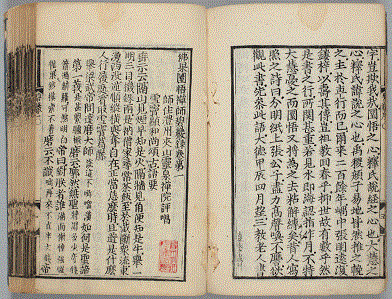
Kyoto Lectures 2022-07-15
15 JULY 22
How Zen Became JapaneseThe Daitō Branch and the Birth of a New Practice in Rinzai Buddhism
Friday, July 15th, 18:00h
Didier Davin SPEAKER
The kanhua chan (Jp. kannazen 看話禅), a practice established by Dahui Zonggao 大慧宗杲 (1089–1163) during the Song period, soon became dominant in Chan (Jp. Zen) Buddhism. According to this method, practitioners must focus on a gong-an (Jp. kōan) until a spiritual explosion occurs, thus opening a passage toward awakening. This kanhua chan was imported into Japan and during the Middle Ages became the basis of the practice in both the Rinzai and Sōtō schools, as in China, Korea, and Vietnam. Around the middle of the fourteenth century, an important evolution occurred: while in other areas where Chan spread a practitioner had to pass only one gong-an to reach awakening, in Japan, several were considered necessary.
By examining the Daitō branch of Rinzai Buddhism, this talk will present the sources through which the history of this significant change can be reconstructed. It will also attempt to answer the question of how—and in part, why—Japanese Zen developed the specificities that radically distinguish it from other lands of Chan practice today.
Didier Davin is an Associate Professor at the National Institute of Japanese Literature. His first research examined the thought of the Zen monk Ikkyū Sōjun. Recently, he has been investigating the doctrinal evolution of the Rinzai Zen school from the fourteenth to the seventeenth century with a specific focus on the so-called Daitō branch, which became the Rinzai school's main branch in the Edo period and is the only one remaining today. Davin has published a study on the reception in Japan of the important Chan text Wumenguan (Jp. Mumonkan) (Mumonkan no shusse sugoroku: Kika shita zen no seiten; Heibonsha, 2020).
This lecture will be held on site (limited space: send us an email in advance) and via Zoom.
The meeting link of Zoom will remain posted on the ISEAS website top page (https://iseas-kyoto.org) and the blog of EFEO Kyoto from two days before the event.
EFEO Kyoto : 29 Kitashirakawa betto-cho, Sakyo-ku, Kyoto, 606-8276 Japan
École Francaise d’Extrême-Orient (EFEO)
Italian School of East Asian Studies (ISEAS)
co-hosted by Institute for Research in Humanities, Kyoto University
kyoto lectures
Friday, July 15th, 18:00h
Didier Davin SPEAKER
The kanhua chan (Jp. kannazen 看話禅), a practice established by Dahui Zonggao 大慧宗杲 (1089–1163) during the Song period, soon became dominant in Chan (Jp. Zen) Buddhism. According to this method, practitioners must focus on a gong-an (Jp. kōan) until a spiritual explosion occurs, thus opening a passage toward awakening. This kanhua chan was imported into Japan and during the Middle Ages became the basis of the practice in both the Rinzai and Sōtō schools, as in China, Korea, and Vietnam. Around the middle of the fourteenth century, an important evolution occurred: while in other areas where Chan spread a practitioner had to pass only one gong-an to reach awakening, in Japan, several were considered necessary.
By examining the Daitō branch of Rinzai Buddhism, this talk will present the sources through which the history of this significant change can be reconstructed. It will also attempt to answer the question of how—and in part, why—Japanese Zen developed the specificities that radically distinguish it from other lands of Chan practice today.
Didier Davin is an Associate Professor at the National Institute of Japanese Literature. His first research examined the thought of the Zen monk Ikkyū Sōjun. Recently, he has been investigating the doctrinal evolution of the Rinzai Zen school from the fourteenth to the seventeenth century with a specific focus on the so-called Daitō branch, which became the Rinzai school's main branch in the Edo period and is the only one remaining today. Davin has published a study on the reception in Japan of the important Chan text Wumenguan (Jp. Mumonkan) (Mumonkan no shusse sugoroku: Kika shita zen no seiten; Heibonsha, 2020).
This lecture will be held on site (limited space: send us an email in advance) and via Zoom.
The meeting link of Zoom will remain posted on the ISEAS website top page (https://iseas-kyoto.org) and the blog of EFEO Kyoto from two days before the event.
EFEO Kyoto : 29 Kitashirakawa betto-cho, Sakyo-ku, Kyoto, 606-8276 Japan
École Francaise d’Extrême-Orient (EFEO)
Italian School of East Asian Studies (ISEAS)
co-hosted by Institute for Research in Humanities, Kyoto University
kyoto lectures
2024
2023
2022
DECEMBER NOVEMBER OCTOBER SEPTEMBER AUGUST JULY MAY APRIL MARCH FEBRUARY JANUARY 2021
2020
2019
2018
2017
2016
2015
2014
2013
2012
2011
2010
2009
2008
anna seidel memorial lectures
architecture
cahiers d'extrême-asie
competition
conference
conferences
conferences
conferences
conservation and renovation of architecture in japan
construction
inauguration
jotoshiki
kyoto lectures
kyoto lectures
kyoto lectures
lecture series
library
news
nouvelles
parutions
prices and distinctions
publications
researchers
visiting scholars
workshop
2023
2022
DECEMBER NOVEMBER OCTOBER SEPTEMBER AUGUST JULY MAY APRIL MARCH FEBRUARY JANUARY 2021
2020
2019
2018
2017
2016
2015
2014
2013
2012
2011
2010
2009
2008
anna seidel memorial lectures
architecture
cahiers d'extrême-asie
competition
conference
conferences
conferences
conferences
conservation and renovation of architecture in japan
construction
inauguration
jotoshiki
kyoto lectures
kyoto lectures
kyoto lectures
lecture series
library
news
nouvelles
parutions
prices and distinctions
publications
researchers
visiting scholars
workshop

